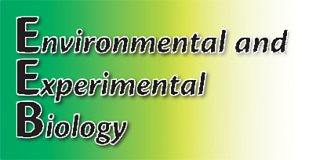
On-line: ISSN 2255–9582

| Faculty of Biology, University of Latvia | ||||||

|
Hard copy: ISSN 1691–8088
On-line: ISSN 2255–9582 Environ Exp Biol (2015) 13: 159–168
|
|||||

|
About the Journal | Retractions | Open Access | Author Guidlines | Current Issue | Archive |
|
Environmental and Experimental Biology |
Environ Exp Biol (2015) 13: 159–168 |
Heterobasidion parviporum-caused root rot is a destructive infection to conifers, especially Norway spruce Picea abies. The disease can be limited by the biocontrol agent fungus Phlebiopsis gigantea. The aim of this work was to study the impact of four previously selected psychrotrophic fast-growing strains of Trichoderma, P. gigantea and combinations of both agents on the growth of H. parviporum in spruce wood blocks and on the structure and chemical composition of wood in laboratory conditions. Stained wood cuts were examined under a microscope and the chemical composition of wood was determined. All investigated Trichoderma strains belonging to species T. viride and T. viridescens inhibited the growth of H. parviporum in the wood. Protective efficiency of Trichoderma spp. against spruce dry weight losses reached 77 to 79%. The study indicated a need for development of combined Trichoderma spp. and P. gigantea plant protection products for biocontrol of root rot. We propose that fast-growing Trichoderma could restrict the colonization of wood surface by rot fungi, while P. gigantea competes with them in deeper parts of wood.